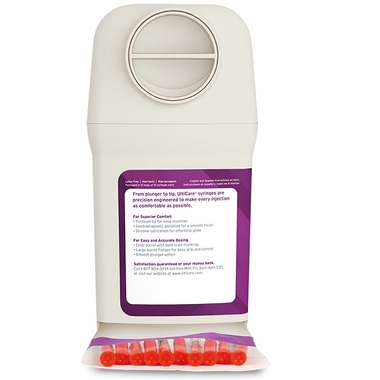SAVE 15% OFF 15% OFF Use Code EPX15 *
UltiCare VetRx U-40 3/10cc UltiGuard Safe Pack Insulin Syringes - 29G x 12.7mm (1/2"), 100 count
- Description
- Directions
- Reviews
Description
UltiCare VetRx Insulin Syringes are used for the injection of U-40 insulin in pets with diabetes. The UltiGuard Safe Pack is the only all-in-one system to store, dispense and dispose of insulin syringes, meeting safe needle disposal guidelines in all 50 states.
UltiCare VetRx premium quality insulin syringes are precision engineered with advanced technology to provide pets with a more comfortable injection:
- Human-grade insulin syringes
- Electromagnetic polished triple-bevel needle for a smooth finish
- Silicone lubrication for effortless glide
- Bold barrel markings and large barrel flanges for accurate dosing and easy grip
Use as directed by veterinarian.
Your veterinarian will prescribe either U-40 or U-100 insulin for your pet. It is critical that you use the corresponding insulin syringe for proper dosing. While U-40 is often prescribed for cats and dogs, it’s important to know there are two types of syringes used for insulin injections: the U-40 syringe has a red cap and tends to be smaller in size versus the U-100 syringe, which has an orange cap and is larger in size.
Instructions for Use come in both English and Spanish. Packaging includes a QR code for resources on pet diabetes care and how to give an insulin injection at home.
Keep out of reach of children. For animal use only.
Directions
View Step by Step Guide for Pet Owners.
Step by Step Insulin Inhection Guide for Pet Owners
Injecting your pet with insulin can feel complicated. To help simplify the process, we've created step by step instructions to show you how to prepare and administer your pet's insulin injections.
Preparing the Syringe
Be sure to read and follow the instructions that accompany the insulin prescribed by your veterinarian. For example, many types of insulin require of the vial to mix the contents before each use. Also make sure you're using the proper insulin syringe: U-40 and U-100 syringes are not interchangeable.

Giving the Injection
Once the syringe has been filled with the correct dose of insulin, take a moment to calm your pet. Giving the injection will go more smoothly if both you and your pet are relaxed. With some pets, it may help to give the ingection while they're eating. You may need to have someone help hold your pet so you can safely give the inhection.


Helpful Hints for Pet Owners
Use the Proper Syringe.
In order to give your pet the correct dose of insulin, talk to your vet to make sure you're using the proper syringe for the insulin they've prescribed. U-40 insulin must be injected with a U-40 syringe, and U-100 insulin must be injected with a U-100 syringe. U-40 and U-100 syringes are not interchangeable.
Use a New Syringe Every Time
To give your pet a comfortable and sterile injection, use a new insulin syringe for every injection. Never reuse syringes.
Sterility is Important.
To help ensure the insulin remains sterile, you should wash your hands before handling the vial and always avoid touching the vial's rubber stopper with your fingers.
Be Precise When Measuring
It's important to be precise and fill the syringe with the exact amount of air that matches the dose of insulin prescribed by your vet. If you inject too much air into the vial, pressure will build up and insulin will leak out. If you don't inject enough air into the vial, the insulin will contain air bubbles when drawn into the syringe.
Distract Your Pet
With some pets, it may help to give the injection while they're eating this can distract them so that little or no restraint is needed and can make the experience less stressful.
Be Quick and Gentle
UltiCare VetRx syringes are very thin and sharp so they won't hurt your pet especially if you insert the needle quickly but gently when giving the injection.
Write it Down
It's a good idea to write down the date and time of each injection. You may also want to make note of the injection site to help ensure you're not using the same location each time.
Share The Responsibility
More than one member of your household should be familiar with the correct procedure for giving your pet an insulin injection. Make sure they also know the current dose prescribed by your vet and which injection sites to use.
























